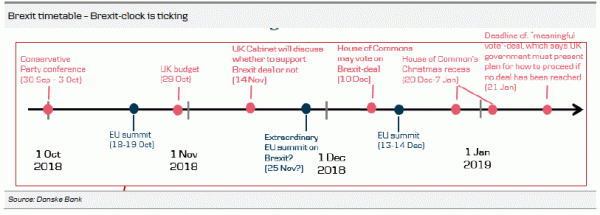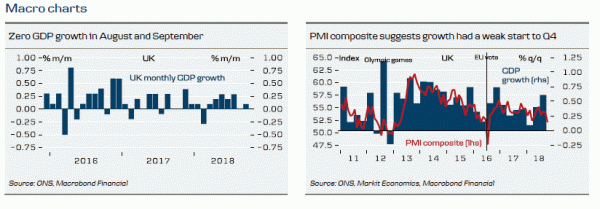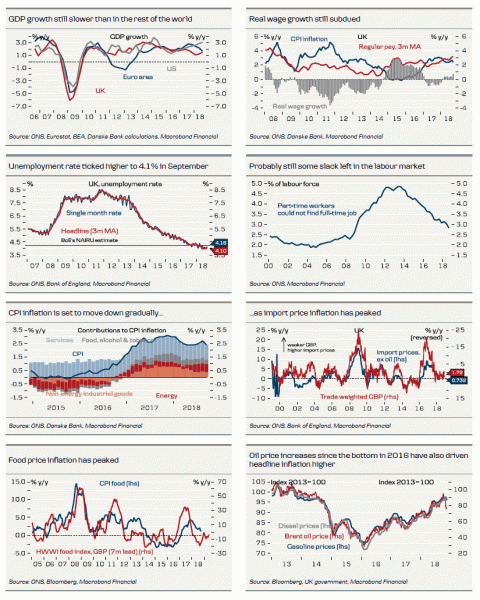Key dates
- Today (14 November): UK Cabinet meets to discuss Brexit deal at 3pm. Will the Cabinet support the deal?
- 25 November (not confirmed): Extraordinary EU summit on Brexit. Deal to be signed (assuming Cabinet says yes)
- 10 December (not confirmed): Possible date for House of Commons vote on Brexit agreement
- 13-14 December: EU summit 20 December to 7 January: House of Commons recess due to Christmas
As expected, PM Theresa May got support for her Brexit deal from the Cabinet. While this was expected, given what the media reported beforehand, it seems like it was not as easy as we had expected. Theresa May said it was a “collective” not a “unanimous” decision, suggesting that some ministers were against. The BBC reports as many as nine ministers probably argued against the deal. Also, we cannot rule out resignations from the Cabinet either already today or over the coming days.
The withdrawal text has also been released (see link (pdf)) and the full deal is nearly 600 pages long with only a few pages for the political declaration on the future relationship, saying that the UK and the EU want a close relationship going forward. According to Bloomberg, the UK and the EU will recognise each other’s financial regulations, so some sort of equivalence, which the EU cannot pull out of overnight. However, banks would still lose a financial passport to the EU’s internal market for financial services.
As anticipated, there will be a review mechanism, which before 1 July 2020 needs to determine whether an agreement on a permanent deal can avoid activating the backstop. Otherwise, the options are to either activate the UK-wide backstop (the UK stays in the customs union [called a single customs territory, see Article 6] including “level playing field” conditions and Northern Ireland obeying many single market rules; the European Court of Justice will continue to have jurisdiction in the UK in certain areas) or extend the transition period for an unspecified period of time (Articles 3 and 132). The UK cannot decide this itself, both sides need to agree. Also, if the UK wants to leave the customs backstop, it needs to be a joint decision with the EU (something the Brexiteers, even the softer ones, have been very critical towards). The UK can notify the EU that it thinks the backstop is no longer needed (Article 20) and the UK and the EU would discuss it at a meeting held no longer than six months afterwards. Still, the Withdrawal Agreement says that the aim is still to sort things out in a permanent deal and that the intention of the withdrawal deal is that it should “only apply temporarily”.
We still expect it to be smooth sailing for the EU leaders to give their consent to the deal when the extraordinary EU summit on Brexit takes place likely on 25 November. The real test is still whether it can pass the UK House of Commons. A date is expected to be held in mid-December (10 December has been reported).
The problem for Theresa May is that both hardliners, Theresa May’s supporting party DUP, the Labour leadership (see The Guardian), LibDems and the Scottish National Party have said they are voting against the deal. That means PM Theresa May needs support not only from the moderate Conservatives but also some Labour MPs. May will probably tell them that it is this deal or nothing, so the strategy is that the Labour MPs would fear a “no deal” Brexit scenario so much that they will vote in favour of her deal.
While markets think it was positive that PM Theresa May got support from the Cabinet, markets are still not getting overexcited just yet. One reason is that it seems like the hardliners in the Conservative Party may try to challenge Theresa May as party leader (requires 15% or 48 Conservative MPs to send a no confidence letter to trigger a no confidence vote). If they succeed in finding 48 Conservatives, the Conservative MPs would vote in a no confidence vote (simple majority). If she loses, the Conservative Party needs to find a new leader, which is probably going to take time, meaning the EU may have to extend the Article 50 deadline on 29 March 2019. The problems for the hardliners are 1) are there enough to mount a challenge to her? 2) Are they risking a second referendum (remember ‘the remain’ camp has tailwind in the opinion polls at the moment)?
Another reason why the GBP movement was limited was that the Cabinet support was expected and the real test is whether it can pass the House of Commons.
When we get more clarification in either direction, we expect to see bigger movements in GBP and until then GBP will stay volatile. We forecast 0.84 in 3M assuming the deal passes.

















